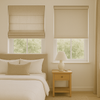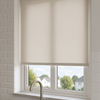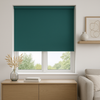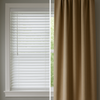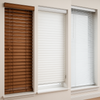The Evolution of Window Treatments: From Wooden Slats to Smart Shades
- by Mariam Labadze
Quick Answer
Window treatments evolved from ancient civilizations' simple fabric drapes (3000 BCE Egypt) through venetian blinds' 18th-century European popularity, Victorian heavy curtains symbolizing prosperity, to modern innovations prioritizing function and technology. The 1940s-1950s introduced aluminum venetians for mass-market affordability, whilst the 1980s-1990s brought vertical blinds and cellular designs optimizing energy efficiency. The 21st century revolutionized window coverings through motorization, smart home integration, and sustainable materials responding to environmental consciousness. Today's treatments combine centuries of aesthetic evolution with cutting-edge technology—voice-activated control, app-based automation, solar power, and AI learning systems creating personalized comfort whilst honoring traditional design principles that proved timeless across generations.
Ancient Origins: Function Before Form
Early Civilizations (3000-500 BCE) – Ancient Egyptians used woven reeds soaked in water hung in doorways and windows, creating primitive evaporative cooling as breezes passed through dampened materials. These practical solutions addressed harsh desert climates long before understanding the science behind evaporative cooling principles.
Chinese and Japanese cultures developed paper screens and bamboo shades providing privacy and light filtering whilst complementing minimalist aesthetic philosophies. These designs influenced modern shoji screens and natural material blinds that remain popular for their simple elegance and environmental sustainability.
Roman architects incorporated fabric drapes in wealthy homes, using heavy textiles demonstrating status whilst providing insulation in stone buildings. The concept of window treatments as both functional and status symbols emerged during this era, establishing patterns that continued through subsequent centuries.
Medieval Period (500-1500 CE) – European castles used heavy tapestries and thick fabrics serving dual purposes—decorative warmth and draft protection in cold stone structures. These substantial treatments also provided privacy in buildings where glass windows remained rare luxuries rather than standard features.
Shutters became common in areas where glass proved prohibitively expensive. These solid wooden panels protected against weather, intruders, and excessive heat whilst allowing ventilation through adjustable louvers—early iterations of principles that modern blinds still employ.
The Birth of Venetian Blinds
18th Century Innovation – Venetian blinds emerged in 18th-century Europe, though their name suggests Venetian origins, they actually developed through Persian and Egyptian influences that European traders encountered. The adjustable horizontal slat design revolutionized light control, allowing precise adjustment impossible with fixed shutters or simple drapes.
Early venetian blinds featured wooden slats suspended by cords, operated through ladder-style tapes and pull cords remarkably similar to modern mechanisms. This design's fundamental effectiveness explains its persistence across three centuries—the basic concept required minimal improvement because original innovation proved so sound.
Wealthy European households adopted venetian blinds as status symbols demonstrating sophistication and connection to international trade networks. The exotic origins and practical benefits combined creating desirable products that craftsmen produced individually for affluent clients.
19th Century Refinement – Industrial Revolution manufacturing capabilities transformed venetian blinds from luxury items into accessible middle-class products. Mass production techniques reduced costs dramatically whilst maintaining quality, democratizing window treatments previously reserved for society's upper echelons.
Patent innovations improved operating mechanisms, introduced metal components increasing durability, and refined aesthetic presentations appealing to Victorian tastes. These refinements established venetian blinds as standard window treatments that remain popular today for their timeless functionality and classic appearances.
Victorian Era: Opulence and Heavy Fabrics
19th Century Excess – Victorian design philosophy embraced ornate decoration and substantial materials demonstrating prosperity and cultural refinement. Window treatments became elaborate productions—multiple fabric layers, complex swags and valances, heavy velvets and brocades creating dramatic presentations impossible to ignore.
These heavy treatments served practical purposes beyond aesthetics—insulating drafty single-glazed windows, providing privacy in increasingly urban environments, and blocking coal fire smoke and industrial pollution common in Victorian cities. Function and fashion aligned creating window treatment approaches that defined the era's interior design character.
The substantial investment window treatments required signaled financial success. Only prosperous households afforded the extensive fabric, skilled dressmaking, and maintenance that elaborate curtain systems demanded, making window coverings effective status indicators in class-conscious Victorian society.
Turn of Century Simplification – As the Victorian era waned, Arts and Crafts and early Modernist movements reacted against excessive ornamentation. Window treatments simplified, embracing natural materials, cleaner lines, and functional designs prioritizing usability over pure decorative impact.
This philosophical shift laid groundwork for 20th-century innovations emphasizing practical benefits—light control, insulation, ease of operation—whilst maintaining aesthetic considerations in supporting rather than dominant roles.
Mid-20th Century: Mass Production and Innovation
1940s-1950s Aluminum Revolution – Post-war aluminum availability from military production converted to civilian use made metal venetian blinds affordable for mainstream markets. These lightweight, durable, easy-clean alternatives to fabric treatments suited modern architectural trends favoring larger windows and cleaner aesthetics.
Aluminum blinds' popularity exploded through the 1950s-1970s, becoming standard in both residential and commercial applications. The association with this era eventually dated aluminum blinds, though their practical benefits ensure continued relevance despite periodic aesthetic dismissals.
1960s-1970s Vertical Innovations – Vertical blinds emerged addressing architectural trends toward floor-to-ceiling windows and sliding glass doors that horizontal treatments poorly accommodated. The vertical slat orientation naturally suited tall, wide openings whilst the rotating slats provided excellent light control.
Early vertical blinds targeted commercial applications before residential adoption grew throughout the 1970s-1980s. Despite subsequent association with dated aesthetics, modern vertical blinds remain practical solutions for specific applications where alternatives prove impractical or prohibitively expensive.
1980s-1990s Energy Consciousness – Energy crises sparked interest in window treatments' thermal properties. Cellular or honeycomb shades emerged featuring distinctive structures specifically engineered for insulation rather than treating energy efficiency as happy accident of designs created for other purposes.
This functional innovation represented philosophical shift—designing window treatments where performance drove aesthetics rather than styling determining form that hopefully provided acceptable function. The approach proved successful, establishing cellular shades as leading energy-efficient options that remain popular decades later.
Late 20th Century: Customization and Variety
Material Explosion – Manufacturing advances enabled producing blinds in countless materials—PVC, faux wood, various fabrics, metallics—providing options for every aesthetic preference, budget level, and environmental condition. This variety transformed window treatment selection from choosing between few standard options into navigating extensive possibilities requiring careful consideration.
Customization became standard rather than luxury service. Made-to-measure treatments in specific colors, patterns, and configurations allowed achieving precise aesthetic visions and perfect fits that mass-produced standard sizes couldn't deliver, democratizing bespoke quality previously requiring substantial investments.
Child Safety Awareness – Tragic accidents involving window covering cords sparked safety reforms throughout the 1990s-2000s. Cordless mechanisms, breakaway features, and improved warning labels addressed hazards that previous generations accepted as unavoidable rather than recognizing as design failures demanding correction.
This safety evolution continues today with increasingly stringent regulations and innovative cordless technologies making safe operation standard rather than premium upgrade, protecting vulnerable children from preventable tragedies.
21st Century: The Smart Revolution
Motorization Becomes Accessible – Early motorized blinds represented luxury features costing thousands of pounds per window. Technological advances and manufacturing improvements reduced costs dramatically—systems once costing £500-£800 per window now available for £200-£350, making automation accessible to mainstream markets.
Battery-powered motors eliminated electrical work requirements, simplifying installation whilst providing reliable operation. Rechargeable batteries lasting 6-12 months between charges offer convenience rivaling hardwired systems without installation complexity that previously necessitated professional electricians.
Smart Home Integration – Window treatments evolved from isolated products into components of comprehensive smart home ecosystems. Integration with Amazon Alexa, Google Assistant, Apple HomeKit, and dedicated home automation platforms enables voice control, smartphone operation, and coordination with lighting, climate, and security systems.
This connectivity transforms window management from manual chores into automated behaviors—blinds opening at sunrise, closing during peak cooling costs, or adjusting based on room occupancy patterns learned through AI algorithms. The convenience and efficiency benefits justify automation investments for growing numbers of households embracing smart home technologies.
Sustainability Focus – Environmental consciousness drives material innovation toward renewable, recyclable, and responsibly sourced options. FSC-certified woods, organic fabrics, recycled materials, and low-VOC finishes address ecological concerns whilst manufacturers implement take-back programs and design-for-disassembly approaches supporting circular economy principles.
Solar-powered blinds represent sustainability pinnacle—window treatments generating their own operational energy through photovoltaic technology, eliminating battery concerns whilst supporting broader renewable energy adoption. Some experimental designs even contribute excess energy to home electrical systems, transforming windows from energy-loss liabilities into active power generators.
Looking Forward: Future Innovations
Transparent Solar Panels – Emerging technology creates transparent or semi-transparent solar panels integrated into blind materials, generating electricity whilst providing window coverage. This revolutionary approach could transform windows into power generation assets offsetting home energy consumption through surfaces previously representing pure energy loss.
Health Monitoring Integration – Future blinds might incorporate sensors monitoring indoor air quality, light levels, temperature, and humidity, automatically adjusting whilst providing data supporting overall home health optimization. Integration with health tracking devices could personalize automation based on actual sleep patterns and circadian rhythm needs.
Advanced Materials – Nanotechnology promises materials with self-cleaning surfaces, dynamic opacity responding to light levels, or thermal properties that actively heat or cool rather than passively insulating. These innovations could transform window treatments from static products into active environmental management systems.
AI Personalization – Machine learning algorithms will increasingly understand household patterns, preferences, and needs, automatically optimizing window treatments without explicit programming. These systems learn what makes you comfortable, then deliver those conditions proactively rather than reactively responding to manual adjustments or rigid schedules.
At 1 Click Blinds, we honor window treatment traditions whilst embracing innovations that genuinely improve daily life. Our range spans timeless wooden venetians echoing centuries of design evolution through cutting-edge motorized systems representing technology's latest contributions, ensuring you find solutions matching your appreciation for heritage, contemporary style, or forward-looking smart home integration.

